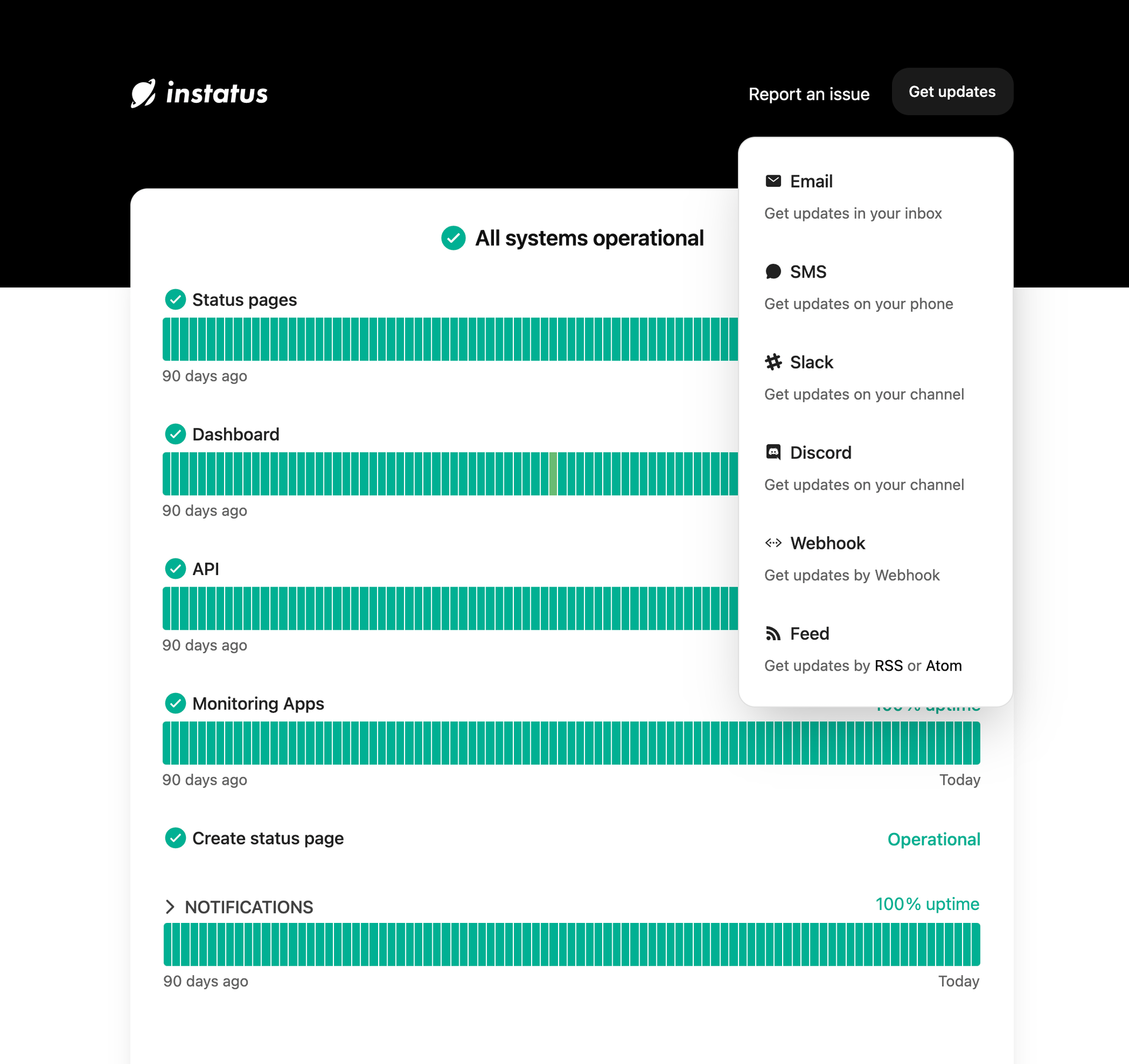A Guide to Successful DevOps Implementation: What it is, Why it Matters, and Best Practices

While DevOps is still a relatively new concept, it’s certainly made an impact in the software industry over the past decade. It helps speed up the application development process, by implementing automation where it can and improves the collaboration between teams. But what actually goes into successful DevOps implementation?
In answer to that question, we’ve put together this Instatus article, where we’ll take a deep dive into the DevOps approach. We’ll look at what it is, why it’s essential, and the steps for successfully implementing a DevOps strategy in your organization.
What is DevOps?
First, what is a DevOps strategy? There’s a lot to unpack here. If you’ve ever Googled the term, you’ve likely found a jumble of words attempting to explain what may seem like an abstract idea. But, it’s not that complicated.
In plain terms, DevOps is simply a combination of the terms “Developers” and “Operations”. It’s a software development strategy designed to help the teams within an organization work together to create high-quality applications as quickly and efficiently as possible. A successful DevOps strategy requires developing new skills and making changes to how your organization functions.
Why is DevOps important?
You might be thinking: ‘why is developing a DevOps strategy so important?’ So let’s answer that question. Below, we’ve broken down a few of the most important reasons why implementing a DevOps strategy is essential for your organization’s success:
Produces higher quality applications
A DevOps strategy not only emphasizes speed, but improved quality as well. A DevOps approach applies best practices in software development to create reliable, versatile code that’s easier to work on and provides a higher quality product for consumers in the long run. This will not only increase customer satisfaction, but creates less maintenance, decreased incident management, and prevents needless releases for you in the long run.
Increases production speed
One of the goals of implementing a DevOps strategy is making the software development lifecycle as short as possible. By automating aspects of the process where possible, improving collaboration between teams, and continuously evaluating performance, overall production speed increases without any sacrifices to quality.
Improves code robustness
A successful DevOps strategy integrates tools to help with configuration management and keeping code robust, which will help create more secure code.
Of course, even the most robust code is never perfect, and occasional hiccups and downtime are inevitable. That’s where Instatus comes in. With Instatus, you can create a user-friendly, easy-to-understand, and modern status page to keep your customers happy even when things aren’t going right.
Instatus offers various themes, configuration options, and status boxes to organizations at an affordable price. We can help you avoid excess tickets and frustrated users, which should be the goal of any software development team.
Components of a successful DevOps strategy
Here are some of the core principles behind implementing a successful DevOps strategy:
-
Collaboration between disciplines
It’s no secret that developers and IT tend to clash. Although members of your organization might have a common goal, it’s not always easy for teams with different responsibilities to work together. When developers and IT collaborate effectively, the entire software development process can be expedited. Working together means less back and forth and leads to quicker releases.
-
Automating where possible
The goal of a successful DevOps strategy is to produce higher-quality software for less time and effort. This means automating the process wherever possible. For example, parts of the development process, such as releasing code to a test environment and performing unit testing, should happen automatically and without delay. No need to reinvent the wheel for every software development lifecycle.
-
Striving to improve continuously
Continuous improvement should always be the long-term goal behind a DevOps strategy. This means evaluating the process after each software development life cycle to assess pain points, delays in the process, and what worked well. It also means monitoring market conditions and being ahead of trends to stay competitive.
How to implement a DevOps strategy
Now that you understand what a DevOps strategy is, the question remains how to implement it. While the exact application of a DevOps approach will look different depending on your organization, the basic premise will remain the same. Here are 5 steps for implementing a DevOps strategy in your organization:
-
Introduce the DevOps initiative in your organization
The first step in implementing a DevOps strategy in your organization is to introduce a DevOps initiative. Your organization’s CIO (Chief Information Officer) will be instrumental in introducing the initiative to IT and using the organization’s resources (such as human resources and finances) in the most efficient way possible. Usually, the CIO will designate a program manager to design the DevOps strategy, oversee its implementation, and ensure that teams are developing the necessary DevOps skills to be successful.
-
Develop the DevOps strategy
In this step, the program manager designs a strategy to integrate the organization’s teams into a common, collaborative environment. This includes drawing in teams such as the developers, designers, and operations employees into a designated DevOps environment. Under DevOps, collaboration is streamlined between the three departments, which helps to improve the production speed and quality of software.
-
Implement containerization
As Amazon explains, “Containerization is a software deployment process that bundles an application’s code with all the files and libraries it needs to run on any infrastructure.” Containerizing is vital for ensuring that code won’t break in different environments. For example, containerized code should work whether it’s in development, the testing environment, or after it’s released in production. Containerizing is a key component of a DevOps approach because it reduces time spent on fixing broken code during the software development lifecycle.
-
Equip your infrastructure with CI/CD tools
If you’re going to put your code in containers, it has to be monitored and updated to ensure it remains compatible across infrastructures. CI/CD tools are designed to help you manage containerized code as efficiently as possible. Some popular examples of CI/CD tools include:
-
Bamboo: Bamboo is a paid tool designed to automate parts of the software release process. It’s designed to assist in managing both software builds and deployments, allowing developers to allocate more of their time and resources towards actual code development. Bamboo also allows you to use parallelism in your projects, meaning you can accomplish multiple tasks at once because of the automation.
-
Jenkins: Jenkins is an open source tool designed to help with software building, testing, and deployment. Developers can use Jenkins to automate tasks, making the software development and deployment frequency quicker.
-
Increase test automation
Where possible, try to increase automated testing. Automated tests make it possible for developers to perform testing while simultaneously writing code. This reduces the time spent resolving bugs after development has been completed. It’s recommended that developers run automated tests daily, so they can fix bugs before writing more code.
-
Monitor application performance
Finally, application performance monitoring is a crucial step in implementing a successful DevOps strategy. Monitoring application performance will help identify pain points and defects in the process that can be improved to streamline the entire process. Your organization will benefit from the quality assurance, improved customer experience, and increased efficiency that application performance monitoring will provide.
While application performance may seem like a straightforward concept, without definable metrics, tracking your team’s improvement can be a bit nebulous. Here are some helpful metrics for assessing your team’s performance:
- MTTR (Mean Time to Recovery): Mean Time to Recovery is about tracking how long it takes for your team to resolve an issue that has caused failure in production. Working to reduce MTTR as much as possible will improve the overall satisfaction of your users and increase your team’s effectiveness. Note that MTTR is different than Mean Time to Failure, and, as far as application performance is concerned, it’s a better metric to track.
- Deployment Frequency: This metric tracks how frequently your team releases new code to users. Higher deployment frequency is a reflection of your team’s efficiency.
- Customer Experience: There are also many metrics that can provide insight into your customers’ experience. Some of these include tracking time to market, lead time to changes, and tracking downtime.
Summarizing DevOps strategy implementation
Implementing a DevOps strategy is not only a good idea, it’s a necessity in today’s development world. Adopting a DevOps strategy will help your organization stay competitive, increase collaboration across teams, reduce the software development lifecycle, and keep your employees and customers happy.
As with anything in the development world, it’s important to expect the unexpected. This means having a user-friendly plan in place for when your application breaks. That’s where Instatus comes in.
With Instatus, when problems in your code occur, your users will see a beautiful and easy to understand status page instead of a frustrating, vague error message. Instatus is an effective tool for keeping customers happy, reducing tickets, and achieving a solution to traditional error messages at an affordable price. Reduce customer frustration with a fully operational status page. Visit the Instatus website to get your free status page
Get ready for downtime
Monitor your services
Fix incidents with your team
Share your status with customers



